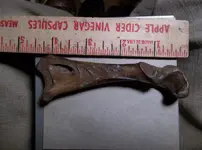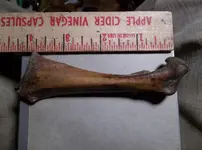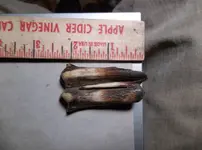You are using an out of date browser. It may not display this or other websites correctly.
You should upgrade or use an alternative browser.
You should upgrade or use an alternative browser.
Any idea what type of bone this is?
- Thread starter BadAdze
- Start date
Archeodeb
Full Member
- Joined
- Nov 3, 2012
- Messages
- 163
- Reaction score
- 82
- Golden Thread
- 0
- Location
- SW Missouri
- Primary Interest:
- All Treasure Hunting
That bone looks awfully robust for its size. Is it mineralized? If so, could be from a now extinct species. We used to find bison and cave bear bones in the Arkansas river near Tulsa, OK a lot. The mud preserves them really well.
Upvote
0
Broken knee
Bronze Member
- Joined
- Dec 12, 2009
- Messages
- 1,894
- Reaction score
- 739
- Golden Thread
- 0
- Location
- in your back yard
- Detector(s) used
- excal 2
Fisher F75 SE
- Primary Interest:
- All Treasure Hunting
Upvote
0
Archeodeb
Full Member
- Joined
- Nov 3, 2012
- Messages
- 163
- Reaction score
- 82
- Golden Thread
- 0
- Location
- SW Missouri
- Primary Interest:
- All Treasure Hunting
Mineralized bones will generally feel a lot heavier than they should. The object is being slowly filled by minerals so sometimes you can actually see small crystals if you look very closely. (Microscope-closely most of the time.)The bone is very hard, but i dont know how to tell if it is mineralized... i did find what i am guessing is horse , maybe bison teeth a few feet from this. ill post a picture.
View attachment 715884
Actually, the process is more correctly called permineralization. What happens is that small amounts of minerals seep into the spaces in the bones (the microscopic air holes between the calcified bits) and gradually fill up all those spaces. They form microscopic endocasts (inside casts -- essentially fossils of the negative space or the "air space"). The original material is still there unchanged, but the bone becomes more solid and hard. Of course, if allowed to sit for a LOT longer, the calcium will be converted as well, and you will end up with a petrified bone where all the original material is replaced.
Upvote
0
Similar threads
- Replies
- 1
- Views
- 255
Users who are viewing this thread
Total: 1 (members: 0, guests: 1)







